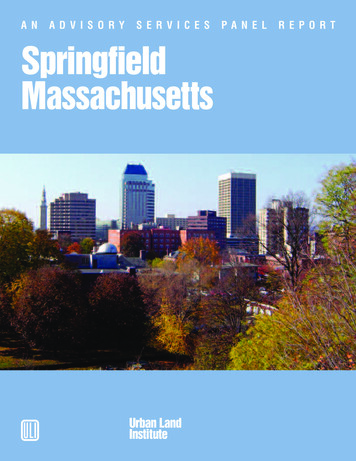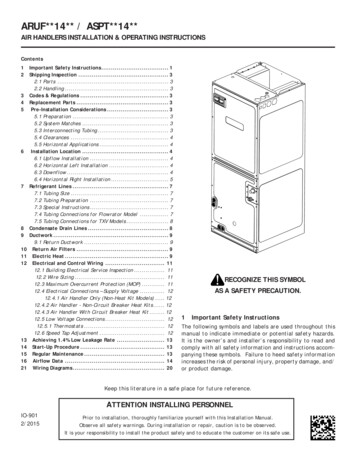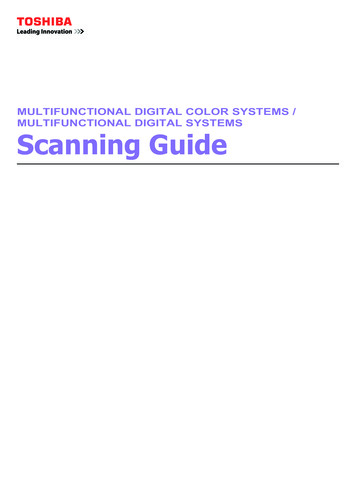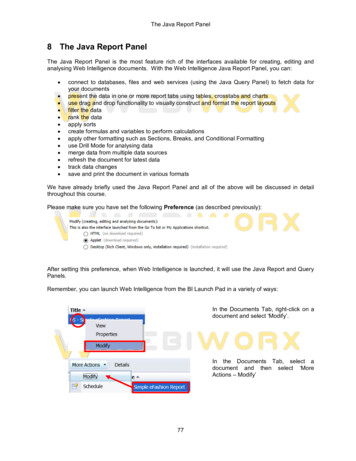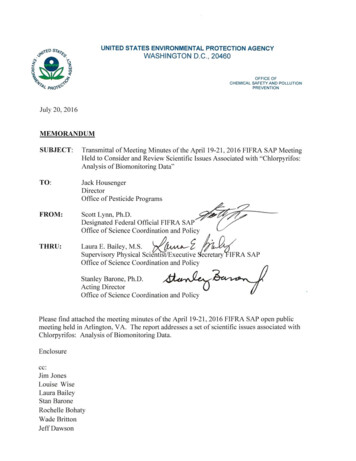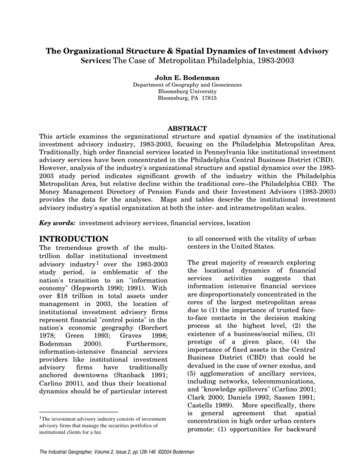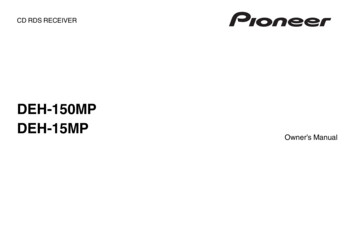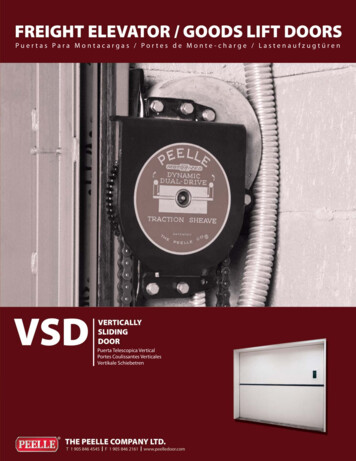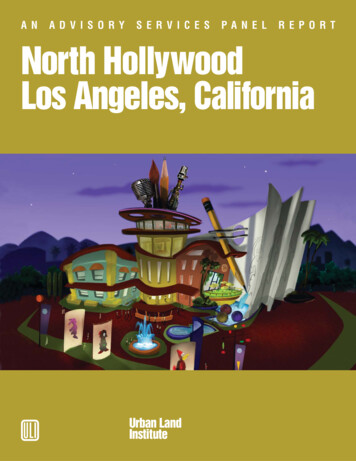
Transcription
A NA D V I S O RYS E R V I C E SPA N E LR E P O RTNorth HollywoodLos Angeles, California Urban LandInstitute
North HollywoodLos Angeles, CaliforniaTransit and the Arts in NoHo: Building a Vibrant CommunityJanuary 25–30, 2004An Advisory Services Panel ReportULI–the Urban Land Institute1025 Thomas Jefferson Street, N.W.Suite 500 WestWashington, D.C. 20007-5201
About ULI–the Urban Land InstituteLI–the Urban Land Institute is a nonprofit research and education organization that promotes responsible leadershipin the use of land in order to enhancethe total environment.UThe Institute maintains a membership representing a broad spectrum of interests and sponsors awide variety of educational programs and forumsto encourage an open exchange of ideas and sharing of experience. ULI initiates research thatanticipates emerging land use trends and issuesand proposes creative solutions based on thatresearch; provides advisory services; and publishes a wide variety of materials to disseminateinformation on land use and development.Established in 1936, the Institute today has morethan 20,000 members and associates from 70 countries, representing the entire spectrum of the landuse and development disciplines. Professionals rep-resented include developers, builders, propertyowners, investors, architects, public officials, planners, real estate brokers, appraisers, attorneys,engineers, financiers, academics, students, andlibrarians. ULI relies heavily on the experience ofits members. It is through member involvementand information resources that ULI has been ableto set standards of excellence in developmentpractice. The Institute has long been recognizedas one of America’s most respected and widelyquoted sources of objective information on urbanplanning, growth, and development.This Advisory Services panel report is intendedto further the objectives of the Institute and tomake authoritative information generally available to those seeking knowledge in the field ofurban land use.Richard M. RosanPresident 2004 by ULI–the Urban Land Institute1025 Thomas Jefferson Street, N.W.Suite 500 WestWashington, D.C. 20007-5201All rights reserved. Reproduction or use of the whole or anypart of the contents without written permission of the copyright holder is prohibited.ULI Catalog Number: ASH068Cover illustration by: David Molina of Creative Capers Entertainment, Inc. Summit Design International, LLC.Text photos by Zane Segal.2An Advisory Services Panel Report
About ULI Advisory Serviceshe goal of ULI’s Advisory Services Programis to bring the finest expertise in the realestate field to bear on complex land use planning and development projects, programs,and policies. Since 1947, this program has assembled well over 400 ULI-member teams to helpsponsors find creative, practical solutions forissues such as downtown redevelopment, landmanagement strategies, evaluation of development potential, growth management, communityrevitalization, brownfields redevelopment, militarybase reuse, provision of low-cost and affordablehousing, and asset management strategies, amongother matters. A wide variety of public, private,and nonprofit organizations have contracted forULI’s Advisory Services.ipants in ULI’s five-day panel assignments areable to make accurate assessments of a sponsor’sissues and to provide recommendations in a compressed amount of time.Each panel team is composed of highly qualifiedprofessionals who volunteer their time to ULI.They are chosen for their knowledge of the paneltopic and screened to ensure their objectivity.ULI panel teams are interdisciplinary and typically include several developers, a landscapearchitect, a planner, a market analyst, a financeexpert, and others with the niche expertiseneeded to address a given project. ULI teamsprovide a holistic look at development problems.Each panel is chaired by a respected ULI member with previous panel experience.Rachelle L. LevittExecutive Vice President, Policy and PracticeTThe agenda for a five-day panel assignment is intensive. It includes an in-depth briefing day composed of a tour of the site and meetings with sponsor representatives; a day of hour-long interviewsof typically 50 to 75 key community representatives; and two days of formulating recommendations. Many long nights of discussion precede thepanel’s conclusions. On the final day on site, thepanel makes an oral presentation of its findingsand conclusions to the sponsor. A written reportis prepared and published.Because the sponsoring entities are responsiblefor significant preparation before the panel’s visit,including sending extensive briefing materials toeach member and arranging for the panel to meetwith key local community members and stakeholders in the project under consideration, particLos Angeles, California, January 25–30, 2004A major strength of the program is ULI’s uniqueability to draw on the knowledge and expertise ofits members, including land developers and owners, public officials, academicians, representativesof financial institutions, and others. In fulfillmentof the mission of the Urban Land Institute, thisAdvisory Services panel report is intended to provide objective advice that will promote the responsible use of land to enhance the environment.ULI Program StaffMary Beth CorriganVice President, Advisory ServicesNancy Zivitz SussmanSenior Associate, Advisory ServicesNicholas GabelAssociate, Advisory ServicesJason BellPanel Coordinator, Advisory ServicesYvonne StantonAdministrative AssistantNancy H. StewartDirector, Book ProgramDuke JohnsManuscript EditorBetsy VanBuskirkArt DirectorKim RuschGraphicsMartha LoomisDesktop Publishing Specialist/GraphicsDiann Stanley-AustinDirector, Publishing Operations3
Acknowledgmentsn behalf of ULI, the panel extends its sincere appreciation to the panel cosponsors:the Community Redevelopment Agency ofLos Angeles (CRA) and the Los AngelesCounty Metropolitan Transportation Authority(MTA). Without the vision, leadership, and commitment to collaboration exhibited by CRA CEOBud Ovrum and MTA CEO Roger Snoble, thispanel would never have gotten off the ground. Theguidance and insight provided by Los AngelesCounty Board Supervisor and MTA Board Chairman Zev Yaroslavsky were indispensable to thepanel, as were the energy and commitment to theNorth Hollywood redevelopment effort evidencedby City Councilman Tom LaBonge and CRA Commissioners Shu Kwan Woo and John Schafer. Thecontinued involvement of all these officials will beessential to the success of this effort, and, in thepanel’s view, the community is lucky to have suchdetermined, dedicated, and skilled leaders.OSpecial thanks are extended to the CRA NorthHollywood office staff led by David Riccitiello, andparticularly to Robert Fazio, who skillfully managed all facets of the panel project, as well as totheir counterparts at the MTA working underthe direction of Carol Inge. In particular, thepanel would like to thank Nelia Custodio for herthoughtful guidance as the MTA representative.The CRA and MTA staffs worked tirelessly toprepare a comprehensive briefing book for thepanel; to arrange for tours and meetings with localbusiness owners, theater managers, and othercommunity leaders; and to orchestrate one of thebest community outreach efforts ever undertakenin preparation for a ULI panel. Special recognition goes to Michelle Banks-Ordone, Daniel Rios,William Mason, and Julia Stewart of the CRAstaff and to Kevin Michel, Kathleen Sanchez, andLynn Goldsmith of the MTA staff for their invaluable assistance. The quality of the market analysis, urban design, and community facilitation services provided by consultants was also impressive,4with the work of Rosalie Udewitz, Robert Goldman, Patricia Smith, John Kaliski and MichaelWells, Sandra Kulli, and Susan Whittaker all making a substantial contribution to the panel’s understanding of the issues.The panel was quite taken with the eloquent andperceptive input it received from members of theNorth Hollywood community. In pictures, personal conversations, letters, and written comments, residents of all ages and backgrounds,business owners and employees, artists, community activists, and others openly shared theirhopes, concerns, and expectations for their community. More than 60 stakeholders took the timeto meet with panel members. Their energy, optimism, and commitment to meeting the challengesfacing North Hollywood were inspiring. Clearly,North Hollywood is a special place in large measure because of the creativity and determinationof the people who live and work there.The panel is grateful to the Universal City/NorthHollywood Chamber of Commerce for the participation of Bruce Spiegel, and to the Mid-town NorthHollywood Neighborhood Council for the involvement of Diann Corral and Eric Reuveni. These aretwo key organizations that work to coordinate andchannel the energy of the community.Two members of the panel, Mark Feinknopf andCynthia Moe, copresidents of Sacred Space in Atlanta, were unable to complete the week owing toa family emergency. The panel was sorry to losetheir expertise and perspective but was gratefulto have the benefit of their insights and writtencomments in its initial deliberations.Finally, the panel wishes to thank ULI TrusteeWayne Ratkovich, who was instrumental in theconception of this panel assignment.An Advisory Services Panel Report
ContentsULI Panel Members and Project Staff6Foreword: The Panel’s Assignment and Summary of Recommendations7Market Potential10Planning and Development Strategies19Implementation31Conclusion40About the Panel42Los Angeles, California, January 25–30, 20045
ULI Panel and Project StaffPanel ChairFrank J. SparicioPrincipalCorporate Real Estate StrategiesRumford, Rhode IslandPanel MembersTerry R. MargerumSenior Managing DirectorSedway Group/CBRE ConsultingSan Francisco, CaliforniaZane SegalProject DirectorZane Segal ProjectsHouston, TexasDouglas BetzPartnerWoolpert LLCDayton, OhioULI Project DirectorsToni L. GriffinDeputy DirectorOffice of PlanningWashington, D.C.Suzanne D. CartwrightDirector, Community OutreachElisa HillSenior Development SpecialistWashington Metropolitan Area Transit AuthorityWashington, D.C.Mary Beth CorriganVice President, Advisory ServicesULI On-Site CoordinatorChiquita ManagoDepartment CoordinatorPolicy and PracticeChristopher W. KurzPresident and CEOLinden AssociatesBaltimore, Maryland6An Advisory Services Panel Report
Foreword: The Panel’s Assignment andSummary of Recommendationshe Urban Land Institute was invited by theCommunity Redevelopment Agency of LosAngeles (CRA) and the Los Angeles CountyMetropolitan Transit Authority (MTA) toexamine development opportunities in the corearea of the CRA’s North Hollywood Redevelopment Project and, in particular, property ownedby the MTA at the North Hollywood subway station.TOriginally a farming community, North Hollywoodevolved into a convenient and affordable residential community that attracted entertainment industry workers, artists, and immigrants, amongothers. Like many first-tier suburban communities, North Hollywood experienced years of decline in the 1960s and 1970s, partly as a result offreeway construction and the development ofshopping malls that took traffic and shoppersaway from the Lankershim Boulevard corridorthat had been the community’s “main street.”The CRA established the redevelopment projectarea in 1979, and its initial revitalization effortshave met with some success, reflected in theHewlett-Packard office building (1985), the Academy of Television Arts and Sciences complex(1991), the community shopping center atVineland and Magnolia (1993), and over 750 netnew housing units, including elderly, handicapped,and low-income units. Since 1993, significantevents have included the 1994 Northridge earthquake and the opening of the Red Line Metro subway station in 2000. The impacts of the earthquake have generally been mitigated, and the newsubway station seems to have catalyzed significant new investment in the blocks near the station, perhaps offering the opportunity to create anew community focal point for North Hollywood.Several new multifamily apartment projects areunder construction, and a major mixed-use project, NoHo Commons, is scheduled to start construction imminently.Los Angeles, California, January 25–30, 2004Another positive element is the emergence of theNoHo Arts District, designated by the Los Angeles City Council in 1992 as a moniker for the area’slively and burgeoning theater and arts scene. Public consciousness of NoHo is slowly but steadily increasing in the greater Los Angeles community. Arecent market study for the proposed World Animation Center museum estimated annual visitorsto the NoHo Arts District at over 175,000.The Panel’s AssignmentThese factors have brought the revitalization effort in North Hollywood to a pivotal point. Ongoing residential development activity, the development opportunities associated with MTA propertyat the Red Line subway station, and the construction of the Metro Orange Line bus rapidway withits terminus station on Lankershim Boulevardacross from the subway are all components thatcan be used to shape a new vision for the NorthHollywood community. This ULI panel was as-15URALOS ANGELES5101SAN BERNARNorthHollywood BurbankHollywoodLos Angeles1550540510AnaheimLong BeachORANGESanta Ana515San DiegoLocation map.7
shimkerVineland AvenueLa nB oulevardBurbank Boulevardsembled to provide advice and recommendationsregarding how the community can capitalize onthese efforts and how future public policy, planning, design, and development decisions can beintegrated to achieve a fully revitalized, vibrant,and sustainable North Hollywood downtown areafor the 21st century.Chandler Boulevard170Cahuenga BoulevardTujunga AvenueMagnolia BoulevardRiverside DriveCamarillo Street101134101Key:CRA North Hollywood Redevelopment ProjectMTA PropertyULI Panel Study AreaPanel study area.Of critical importance is the future development ofstrategically located sites owned by the MTA, including the 10.45-acre subway station site and twosmaller parcels (1.8 and 1.9 acres) located directlywest across Lankershim Boulevard on either sideof Chandler Boulevard. (See panel study areamap.) Maximizing the potential of these sites, andintegrating the new development with the transit services and the arts district, will be crucial indetermining the character of the community andin meeting redevelopment goals. While the panelmade detailed recommendations for these properties, it also considered planning, design, and development strategies for the arts district and thebroader redevelopment project area.The panel wrestled with the question of the relative importance of the arts district in the redevelopment plan. Beyond the immediate communityof actors and artists who live and work in the NoHoarea, the NoHo Arts District does not appear tohave substantial name recognition within thegreater metropolitan region. One most likely couldnot get in a cab at the Los Angeles InternationalAirport and ask to be taken to NoHo without receiving a blank stare from the driver. Other partsof the region have arts offerings that equal or exceed those found in NoHo. Preservation of thelow-rise, inexpensive buildings necessary to fosterthe community’s small, experimental theaters andavant-garde galleries could be expensive andmight conflict with rising land values and increasing market demand for other uses generated inpart by the presence of significant transit service.The Panel’s RecommendationsExcellent transit accessand the NoHo Arts District are key North Hollywood assets.8The panel came to the conclusion, however, thatNoHo’s funky arts identity is an irreplaceable partof the community’s character—a character that inand of itself is an important catalyst for redevelopment activity and that will enhance property valAn Advisory Services Panel Report
ues for both existing and new development. Preserving this character will take determined work,but the panel believes strongly that it will be wellworth the effort. This report contains several recommendations for achieving this important part ofits vision for NoHo.The second big question that the panel discussedat length was how to direct and control the development of the MTA sites and surrounding areasto achieve a more livable environment for all. Thepanel’s vision focused on creating walkable streetsthat encourage leisurely shopping, café dining, gallery hopping, and a safe and convenient evening atthe theater, a movie, or a concert. Such places alsoare attractive locations for employees, especiallywhen combined with the superior transit servicethat is increasingly available in North Hollywood.Achieving this urban village atmosphere will require immediate attention to creating a balancedplan, given the strong rental residential marketand the number of projects already in the development pipeline. An overall design plan with detailed development guidelines must be put in placeso that each new building will contribute to quality of the community and not detract from it.The condition of the public realm—the streetscapes and green spaces (or the lack thereof)—was an important focus for the panel. While adenser built environment is both inevitable anddesirable—especially if it results in reduced vehicle traffic through transit use and more walking—it must be balanced with a well-thought-out network of greenways, open spaces, parks, and peo-Los Angeles, California, January 25–30, 2004ple-friendly streets. At the same time, the availability of a sufficient amount of well-located andvisually unobtrusive parking is critical for safetyand the economic vitality of the area’s businessesand arts venues. The panel devoted considerabletime to considering how best to balance the needto accommodate vehicular traffic with the humanscale, pedestrian-oriented spaces that make acommunity an attractive place to live, work, shop,and play.Finally, given the impossibility of successfullyplanning and implementing a complex redevelopment plan without extensive collaboration witha multitude of stakeholders, the panel focused onthe CRA and MTA development review processesand on how they can work together more effectively. Much good work has already been done,and the panel encourages the agencies to take thefinal steps necessary to begin implementation ofa shared vision for NoHo. Now is the time to takethe necessary actions to preserve and strengthenthe arts district, to plan for balanced development,to invest in the public infrastructure, and to beginto build a new future for North Hollywood.This report summarizes the panel’s conclusionsand recommendations, which were delivered tothe sponsors during a public presentation on January 30, 2004. The panel hopes that the findings inthis report will contribute to the successful redevelopment of North Hollywood.9
Market Potentialorth Hollywood is a district within thecity of Los Angeles, located in the east SanFernando Valley, over the hills from Hollywood and approximately ten miles fromdowntown. As such its boundaries are not precisely defined, but it generally encompasses anarea between the 101 Ventura Freeway on thesouth, Sherman Way on the north, the 170 Hollywood Freeway on the west, and the city of Burbank on the east.characteristics are lower than in nearby submarkets such as Studio City, Universal City, andBurbank. The area’s largest employers are twomedical firms, two department stores, and aninsurance company, all with 300 to 400 employees.By contrast, Burbank and Universal City’s majoremployers are entertainment companies with upto 7,500 employees.The statistical data gathered by the CRA for thisadvisory panel used somewhat larger boundariesstretching as far west as Van Nuys Boulevard.Both of these areas are considerably larger thanthe CRA’s redevelopment project area and theMTA station area that were the foci of the panel’sanalysis, as shown on the ULI panel study areamap. The area within which market and demographic data was collected is referred to as thegreater North Hollywood market study area,shown in the accompanying figure. These boundary differences should be kept in mind when considering the economic and market data discussedin this report.As of July 2003, the overall Los Angeles office vacancy rate was 15.8 percent and full-service rentswere at 28.80 per square foot, down slightly from 29.88 in 2002. At present rates of absorption itwould take 4.5 years even to reach the 10 percentvacancy benchmark. For the overall North Hollywood market, which comprises about 2.35 millionsquare feet, vacancy is at 15.4 percent with rentsbetween 8 and 33. However, the three majorbuildings nearest the Metro station contain about510,000 square feet and appear to be about 7 percent vacant, with rents in the mid-twenties. A majority of tenants are reported to be entertainmentindustry–related.Economic and Demographic Overview(1990–2000)There is no question that, all other things beingequal, the MTA station enhances the potential forcreating an office node in this part of North Hollywood, particularly for entertainment industryusers. Current rents, however, do not support thecost of new construction and any near-term project would likely require subsidies. If a few keysites are designated for office use and a proactiveand sustained marketing effort is made, office usesmay well be achievable within five to ten years.NThe population of North Hollywood grew by almost 11 percent between 1990 and 2000 to a totalof 239,279, with a major increase in the Hispanicpopulation, which now constitutes 45.6 percent ofthe total. The Hispanic population is concentratednorth of Burbank Boulevard, where it encompassesnearly two-thirds of the populace. Incomes grewby 20 percent, less than the 30 percent increasein the Los Angeles metropolitan area’s ConsumerPrice Index. The area has a skewed distributionof household sizes, with a disproportionate amountof both large (six or more persons) householdsand singles. Educational, employment, and income10Office MarketRegional and Subregional RetailMarketNorth Hollywood’s traditional retail strengthsare in department stores and auto supplies. TheAn Advisory Services Panel Report
nSa5Hollywood WayVineland AvenueLankershim BoulevardLaurel Canyon BoulevardVan Nuys BoulevardColdwater Canyon AvenuedoanrnFeRoscoe BoulevardSherman Way170Victory BoulevardKey:North HollywoodBurbankBurbank BoulevardStudio CityUniversal CityMagnolia Boulevard101134101012 MilesTo Downtowngreater North Hollywood area is served by tworegional shopping centers, Westfield FashionSquare in Sherman Oaks and Panorama Mall/Walmart in Panorama City. The latter caters tothe large Hispanic population. The subregionalmarket is dominated by the Burbank Empire Center, Burbank Media Center, and the Valley Plazashopping center, an old subregional center locatedapproximately two miles to the northwest, whereSears and Robinsons May department stores arelocated. There are more than 70 multiplex moviescreens in North Hollywood, Burbank, and Universal City, most in configurations of ten or morescreens. Of these retail establishments, only theauto supply stores are prominent in the immediatestudy area.Retail prospects in the station area do not seempromising for a destination “town center” mallLos Angeles, California, January 25–30, 2004configuration with major comparison-goods retailers and a multiplex cinema. A more organic MainStreet model, with local niche retailers such asgalleries and vintage clothes shops, interspersedamong the existing theaters and restaurants,seems more appropriate.The North Hollywoodmarket study area is considerably larger than thepanel’s study area, whichis located entirely inNorth Hollywood.Convenience and Neighborhood RetailThere appears to be a healthy local retail market,with 13 centers (approximately 600,000 squarefeet) and a vacancy rate of 5.6 percent. Rentsrange from 1.25 to 3.50 (triple net), with thehighest rates in Sherman Oaks and Studio City.Rents in the Magnolia Vineland Center are in the 1.50– 2 range, and vacancy is reported at 1.1 percent. The Ralph’s grocery store in the center is reportedly one of the chain’s best performers. In addition, two other grocery chains, Hows Markets11
the wave of new, relatively affluent residents whowill occupy the 1,500-plus apartment and loft unitsnow in the development pipeline.It is important to realize that, by itself, the transitinvestment does less for retail than for residentialor office development. In the words of a recentULI report, Successful Development aroundTransit, “retail must be viable on its own.” Retaildoes not drive development around transit, butrather “follows rooftops.”Multifamily Residential MarketIn the greater North Hollywood market studyarea, multifamily units constitute 64 percent of the59,000-unit residential inventory. Between 1990and 2000, the greater North Hollywood marketstudy area added 2,763 units, more than half ofthem in projects of 50 or more units. Within thisarea, renters lease 68.1 percent of occupied units,as contrasted with Burbank, where the number is56.4 percent.Above: Eclectic localretailers create a distinctive ambience. Right: TheNorth Hollywood multifamily residential markethas been strong in recentyears.The overall vacancy rate is 3.2 percent, and rentsvary greatly depending on the quality and vintageof product. The high end is about 2 per squarefoot per month. Over 1,500 new apartment unitsare approved or under construction in the studyarea, about 90 percent at market rate. They are allprojecting market rents in the 1.75– 2 range.and Henry’s (a subsidiary of Wild Oats) have expressed interest in the NoHo Commons site.More broadly, the local retail scene is rather funkyand eclectic, reminding some observers of Melrosein an earlier day or of various neighborhoods inBerkeley or San Francisco. In addition to artsrelated retailers, one growing niche is that of vintage clothes shops. A recent market study reported that there were over 60 restaurants ofdiverse types in the arts district, nearly half ofthem serving Asian cuisine.Since the panel did not receive specific data onrents, vacancy, and turnover for the local retailerson Lankershim and Magnolia boulevards, it is reluctant to draw detailed conclusions. Overall, however, the local retail scene appears stable, and itshould be expected to benefit substantially from12The average value of condo resales is 244,000,compared with single-family homes at just under 277,000. The average sales price of condos/townhomes was 205 per square foot in 2002. Currentlyno for-sale product is under construction, but twoare scheduled to start construction this spring: 36condominiums on Burbank Boulevard and 69 loftson the former Adolph’s Meat Tenderizer warehouse site. New condos in Burbank are being marketed at an average price of 305 per square foot.The panel anticipates that more for-sale productwill emerge as the area’s desirability becomesmore evident, and it believes that such development should be encouraged with policies that support homeownership.It remains to be seen whether the projected rentswill be fully achieved with so much new productcoming on market so quickly. Given the low vaAn Advisory Services Panel Report
cancy rates, however, area housing developershave cause for optimism. Regardless, the longterm prospects for NoHo as a major transitoriented residential node are excellent, due bothto market trends and to locational advantages.With its Red Line and future rapid bus stations,North Hollywood is well positioned as an urbaninfill site to capture a significant share of futuresubregional residential growth.While this growth potential is very positive forthe local economy, including the arts district, thereis a danger that, without any intervention, thestrong residential market could crowd out otheruses that are equally important to the area’s longterm economic health. The CRA may wish to consider policies for ensuring provision of housingtargeted at the local work force, seniors, and lowincome people in general; reserving a few keysites for employment-generating uses such asoffice and retail; and preserving certain singlefamily neighborhoods.Hotel MarketNo hotel market data were collected for the panel,and thus the following comments are based on thepanel’s familiarity with hotel markets in the UnitedStates and California generally and on selected interviews with industry professionals. There arecurrently no hotels in the NoHo district.Generally speaking, it continues to be a difficulttime for new hotel development. Even strongplayers such as Hyatt and Marriott can have trouble finding financing. The hotel developers thepanel spoke with saw no foreseeable potential forhotel development in the North Hollywood stationarea because “there’s no reason to go there.” Thisview could change if the station area builds out, asanticipated by some of the recent forecasts promulgated by developers and planners.Clearly there are no major destinations in thearea now. However, just one short Metro stopaway is City Walk and the Universal City themepark, the top tourist destination for visitors to LosAngeles County. The panel believes it may beworthwhile to explore with selected hotel companies or developers the pre– and post–September11, 2001, performance of Universal City hotels andLos Angeles, California, January 25–30, 2004to solicit their views on NoHo generally. Anotheroption to explore is an extended-stay “suites” hotel,geared toward entertainment industry workers.Oasis Arena FacilityThe Academy of Television Arts and Sciences isan important entertainment industry anchor inthe study area.This proposal for an 8,000-or-more-seat arena,which has been presented to the MTA for one ofits transit station properties, deserves specialmention. The expected events include college andminor-league professional sports, conce
North Hollywood Los Angeles, California Urban Land Institute. North Hollywood Los Angeles, California Transit and the Arts in NoHo: Building a Vibrant Community January 25-30, 2004 An Advisory Services Panel Report ULI-the Urban Land Institute 1025 Thomas Jefferson Street, N.W.
